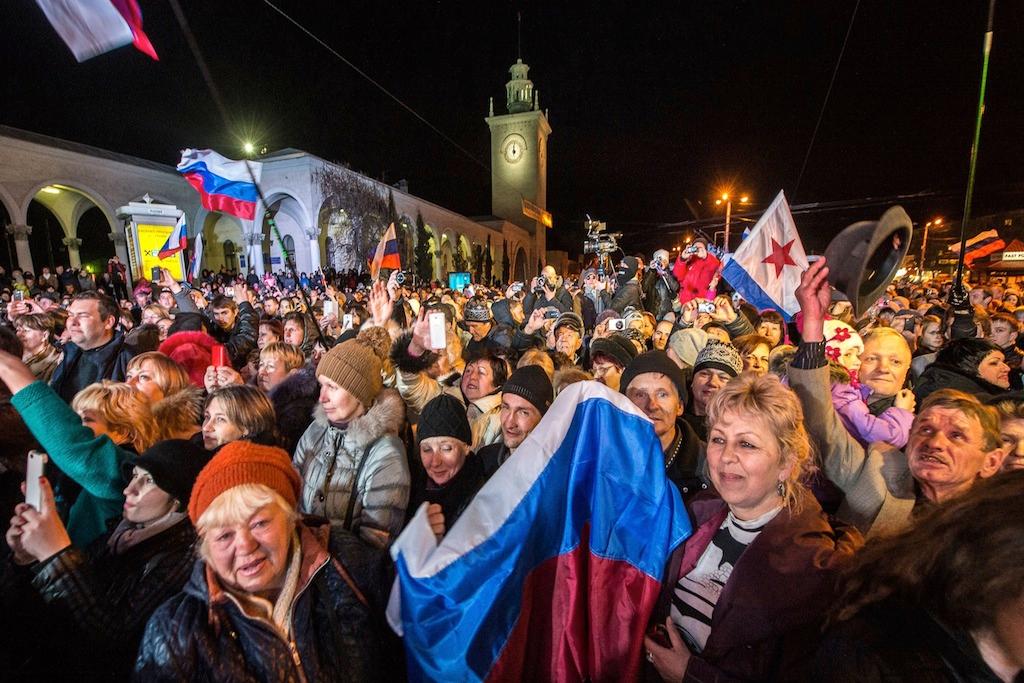Kremlin narrative of ethnic struggle between Russians and Ukrainians does not hold up
People celebrate the transition to Moscow time near a city clock tower at a railway station in Simferopol on March 30, 2014. As the rest of Europe was set to move their clocks one hour forward for summer on Sunday, in Crimea, residents braced for a two-hour jump into the timezone of their new masters in Moscow.
CHICAGO — In December of 1825, a group of Russian army officers and their soldiers refused to swear allegiance to the new tsar, Nicholas I and took a position in St. Petersburg main square to demand the constitutional limits on autocracy.
After brief negotiations, Nicholas ordered artillery fire to disperse them. Hundreds died, five leaders were hanged, others exiled to Siberia. This marked the beginning of one of the most repressive periods in the history of the Russian empire, when all dissent was squashed, the Polish Uprising suppressed by arms in 1830, and the brutal war in the North Caucasus claimed the lives of millions native and Russians alike over the next 30 years.
Enter Vladimir Putin, Russia’s new autocrat. His return to presidency in 2012 was accompanied by huge protests. More than 150,000, disgusted with disingenuous elections and Putin’s engineered return, took to the streets of Moscow.
The demonstrations were specifically anti-Putin, the man who represented the pervasive corruption, the rule of security services in bed with the oligarchs, and repressive, undemocratic society.
For Putin, there was only one conclusion—Russia’s new middle class acquired too much freedom and needed to be brought into line. Since then, step by step through the kangaroo courts and rubber stamp parliament, the Putin regime tightened the screws turning Russia into a genuine police state. Simultaneously, the Kremlin resumed to stoke the fires of Cold War rhetoric, virulent anti-Americanism and Russian chauvinism.
Shortly after ascending the throne, the emperor Nicholas I realized that he needed more than repressions. He needed an ideology to cement his repressive empire.
It was at this time, in the second quarter of the nineteenth century, that the tsar’s Minister of Education and the president of the Russian Academy of Sciences, Count Sergei Uvarov, formulated the triad of Russian conservative nationalist ideology: autocracy, orthodoxy and official nationality defined Russianness and became the three pillars of the Russian empire.
The fact that the Russian empire was populated by millions of non-Russians and non-Orthodox — Catholics, Muslims, Jews and Buddhist — did not seem to bother the emperor.
Today’s Russia is a full-fledged autocracy that heavily relies on the support of the Orthodox Church, which continues the centuries-old tradition of being wholly subservient to the interests of the state. In return, Putin’s autocracy is seeking to define Russia as a Russian Orthodox state.
One need only recall the opening ceremony of the Sochi Olympics, which made no single reference to the 28 percent of Russia’s non-Russian population. Instead it presented a stark official vision of “Russia for the Orthodox Russians.”
In recent days, the Kremlin’s vision has evolved further to include the Ukrainians and Belarusians in a sort of Slavic Russia that Putin vaguely articulated in his speech on March 18..
A modern Russia that seeks inspiration in its own reactionary past is a clear danger to the West. Instead of pursuing integration with Europe, Putin’s Russia positioned itself in opposition to Europe and its values.
Putin considers any move toward an open and democratic society within and outside of Russia an existential threat. And nothing is more of a threat to Putin’s regime than Ukraine.
Precisely because the Kremlin traditionally considered Ukrainians as no more than the wayward younger brothers, it cannot accept Ukraine as a sovereign nation-state that seeks closer ties with Europe.
The stunning amount of propaganda from Moscow largely succeeded in imposing the Kremlin’s narrative of the violent ethnic conflict between Ukrainians and Russians. In fact, it is not an ethnic conflict. It is a conflict between a fledging democracy and a calcified autocracy. For Moscow, Ukraine is indeed a red line, beyond which democracy has to be contained.
The main question today is how Russia can be stopped. Back in the first half of the nineteenth century, in violation of the several treaties signed by Russian and the European powers, Russia aggressively expanded into the territories of its weaker neighbors, the Ottoman and Persian empires.
It took several decades before the European powers finally understood that Russia had to be confronted before Russia occupied Istanbul and the Strait of Bosporus.
Then as now, the pretext for war was Russia’s claim to protect the Russian Orthodox community outside of Russia. During the following three years, of what became known as the Crimean War (1853-56), Russia suffered a humiliating defeat from the superior military forces of Britain and France. It was in the wake of this military defeat that the Russian tsar, Alexander II, launched the most comprehensive liberal reforms in the Russian empire.
It was famously observed that since the early eighteenth century Russia was expanding at the rate of one Belgium a year. The Crimea happens to be almost the same size as Belgium. The year is 2014. Only the naive or apologetic may not see that for Putin’s Russia, the Crimea is just the beginning.
Michael Khodarkovsky is a professor of history at Loyola University Chicago, who specializes in the history of Russia's frontier and imperial expansion into the Eurasian borderlands.
The story you just read is available for free because thousands of listeners and readers like you generously support our nonprofit newsroom. Every day, reporters and producers at The World are hard at work bringing you human-centered news from across the globe. But we can’t do it without you: We need your support to ensure we can continue this work for another year.
Make a gift today, and you’ll get us one step closer to our goal of raising $25,000 by June 14. We need your help now more than ever!
